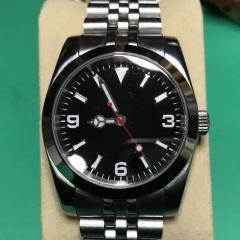Hallo from Germany to all WRT members
-
Recently Browsing
- No registered users viewing this page.
-
Topics
-
Posts
-
Nice rescue. I like when a few with heavy patina are worn in rotation with nicer watches of a collection. Frankens, too so long as they aren’t passed off as something else. My experience with these Seikos is they tended to disintegrate on their own so finding correct parts to put an original together is near impossible…
-
Some answers from my view screwdrivers - if the bodies are ok for you maybe only look at changing the blades if possible, probably 100 and 140 first. loupes - 3-3.5 is what is normally recommended for disassembly and assembly, 10x for inspection digital microscope - not great for working on movements as there is no depth perception, great for inspection and taking photos to post here 😀 automatic oilers - a bite marmite/vegemite at times, various opinions, some swear by them, some use them only for certain jewel settings others don’t care for them at all. They are not at all necessary, the usual alix etc. ones are fine and you don’t need to spend a fortune. They are very subjective though, you may end up making your own from a needle and peg wood because you like it just so. can’t help with the Geiger counter, I’m one of the ones who don’t get freaked out about it. There is a legitimate concern, however as long as your not licking the dials/hands, or snorting the degraded old powder you are likely to be absolutely fine. Tom
-
If you've got a stem for an ETA C01.211 then it should be correct. The other possibility is that the tip of the old stem has snapped off and is still in the movement. You can compare the piece your removed to confirm it's correct and not broken. Photos as always would help.
-
Thanks for the reply! How do I find out exactly what replacement stem i need please! I’ve just had at that pdf file you’re just sent & i can’t make head no tails of the item required mate! Sorry to be a pain!
-
Game on! ST36 has arrived, but there's still a few questions and I'd be grateful for your help. I've got a set of cheapo Chinese screwdrivers that I bought years ago, so I'll use it for now for learning. Decent tweezers in the post. I also have a clip-on cheapo Chinese loupe 5x. Looking at the ST36, I am guessing that I need a 10x? I happen to have a (cheapo) digital microscope too - am I better off just learning to work under the microscope right from the start? For oiling, am I really better off getting automatic oilers, or should I learn with regular ones? Any of you folks use geiger counters? Are cheap ones (~£20-30 off ebay) good enough for checking watches, just in case they are hot? I intend to avoid lume unless it's tritium, but you never know what you're dealing with.
-


.thumb.jpg.19a9c4ff164d78d516aa9f05a063752b.jpg)




Recommended Posts
Join the conversation
You can post now and register later. If you have an account, sign in now to post with your account.
Note: Your post will require moderator approval before it will be visible.